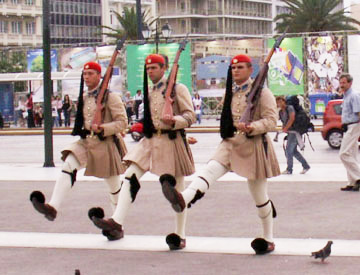Greek Costume Stamps
In 2007, I got to go to Athens (the real one in Greece — we have one in Texas too but it’s not quite as famous) on very short notice. Usually when I get to go along on one of my husband’s business trips, we only stay somewhere for 3 days, but this time we got to stay almost a week. I didn’t have time to do any research before we left, so we just wandered around, hitting all the usual tourist activities.
(I also didn’t have time to learn any Greek, and that made at least one shopkeeper angry, so I am sad to say that I gave support to the stereotype of the ugly American*. But I did learn to say “efkharisto” [“thank you”] very quickly. **)
In the flea market of Monastiraki, I bought myself a little album of stamps as a souvenir. I don’t collect stamps but the pages looked like little patchwork quilts and I thought I would use them for inspiration.
Just lately I looked at it again, and realized that there was a set of stamps showing regional costumes!
Here are some of my favorites:
Now if you just have to have a set of these for yourself, there are several for sale on the usual auction sites, going for a grand amount of a euro for the whole set!
I have always been more into household textiles like rugs, blankets, and towels, than into traditional costumes. I always assumed that the different styles just evolved from the Middle Ages onward, but according to the book Rural Costume, that is not so.
Although there had been for some time a few distinctive regional dresses, or features, such as the head-dresses of the Basques, the costume of the North Holland people and their cousins, the Amager folk of Denmark… the costumes which could be assigned to one particular village or religion or status did not blossom into their full glory before the middle or even the last quarter of the eighteenth century. Only then were the better-off peasants in a position to indulge in “infinite variety” and richness of design and materials, though this was mostly apparent in the gala dresses for Sundays and feast days.
Complete freedom from tied service to landlords, the buying of their own farms, and the abolition of sumptuary laws were… the causes of these changes; the people were then left to buy as their pockets, taste and village fashion dictated. When a costume was regional, what you might wear and how you might wear your dress and its details was more or less rigid. Nevertheless, new details were introduced by young men and girls…But the basic garments remained unchanged.
- Alma Oakes and Margot Hamilton Hill, Rural Costume: Its Origin and Development in Western Europe and the British Isles, 1970, B.T. Batsford Ltd. (italics original)
To be fair, this book is from 1970, so new research could have been done since then, and it does not include Greece, so maybe things were different there. But it does seem to fit in with lots of textile history books that I’ve read, that point out that it took exploration, trade, and the Industrial Revolution, for people to be able to accumulate enough extra stuff that they could be expressive with it.
Now what I wish I had bought were the vintage linen sheets I saw, with beautiful red embroidery. If I ever go back, I will look for them!
*In my defense, I do speak pretty good Spanish, and some French and German. I did not know how to say that in Greek though, so the shopkeeper just had to draw her own conclusions.
** In the Lonely Planet phrasebook I bought, how to say “thank you” does not come up until page 74! Following such phrases as “Can I stay at your place?” “Where can we hire an uncrewed boat?” and “I should never have let you near me!” Maybe that is why those Lonely Planet people are lonely.






















Those stamps are wonderful! And I laughed out loud at the last comment, about Lonely Planet. It can’t be easy to be the newer travel guide on the block and to find new ways to approach things . . .
I didn’t realize they were trying to stake out new territory in the phrasebook field when I chose this one based on its small size and readability. But they do have whole sections on pick-up lines, rejection, and “relationship success”. If I ever need to say, “Which way to the nudist beach?” or “Easy, tiger,” or even “Will you marry me?” I am set! Of course I can’t really imagine whipping out a phrasebook and successfully finding the line I am looking for in a dimly lit nightclub.
Sumptuary laws! I had not given them much thought as to their influence on how people dressed, but I recall now that they seemed hell bent on ensuring people didn’t dress above their appointed station in life. I recall the Puritans in this country may have had rules along those lines, but anymore only the Amish are eager to put a damper on self expression through dress.
There is a section on sumptuary laws in the back of the Rural Costume book, so your comment made me think I would do a post on them. But when I read that section, it doesn’t have the actual language of the laws, just a rather boring summary. Also, you are right, they are so depressing because they are all about keeping people in their proper station. I lost the will to read more about them.
A lovely collection of stamps and a nice story to go with them. I have been to Athens and know the market you visited, but no bargains for me.
Well, it may have not been a bargain. But I thought it would likely be my only trip to Athens so I went ahead and got it. I hope I do get to go back — writing about it in that post has made me hungry for the fabulous roast lamb, potatoes, and eggplant I had one night, and the tzatziki I had another night….
The stamps are beautiful. I love buying old (and new) stamps from different countries. Sometimes I lament how boring ours can be.
Some of ours are pretty interesting, but when I was online looking for “postage stamps with costumes” I saw some beautifully detailed ones from Grenada. I guess some of those small countries create interesting stamps to get income from outside their country, and I know they got my attention! I may have to start collecting, they’re an easy thing to get and they don’t take up much space! 🙂
Now I wonder what pictures of regional costumes would look like for the U.S.!
I actually did a post when we finally had some textile workers on stamps in 2014: https://textileranger.com/2014/04/04/a-little-commemoration-here-please/
Pickings were pretty slim. We had a series of 4 “holiday knits” and a series of 5 “Aloha shirts”, and one set that I missed in that post was a 1996 set of 5 American Indian dance dress. There is a lot of room for improvement in that area!
Pingback: Greek Costume Dolls | Deep in the Heart of Textiles